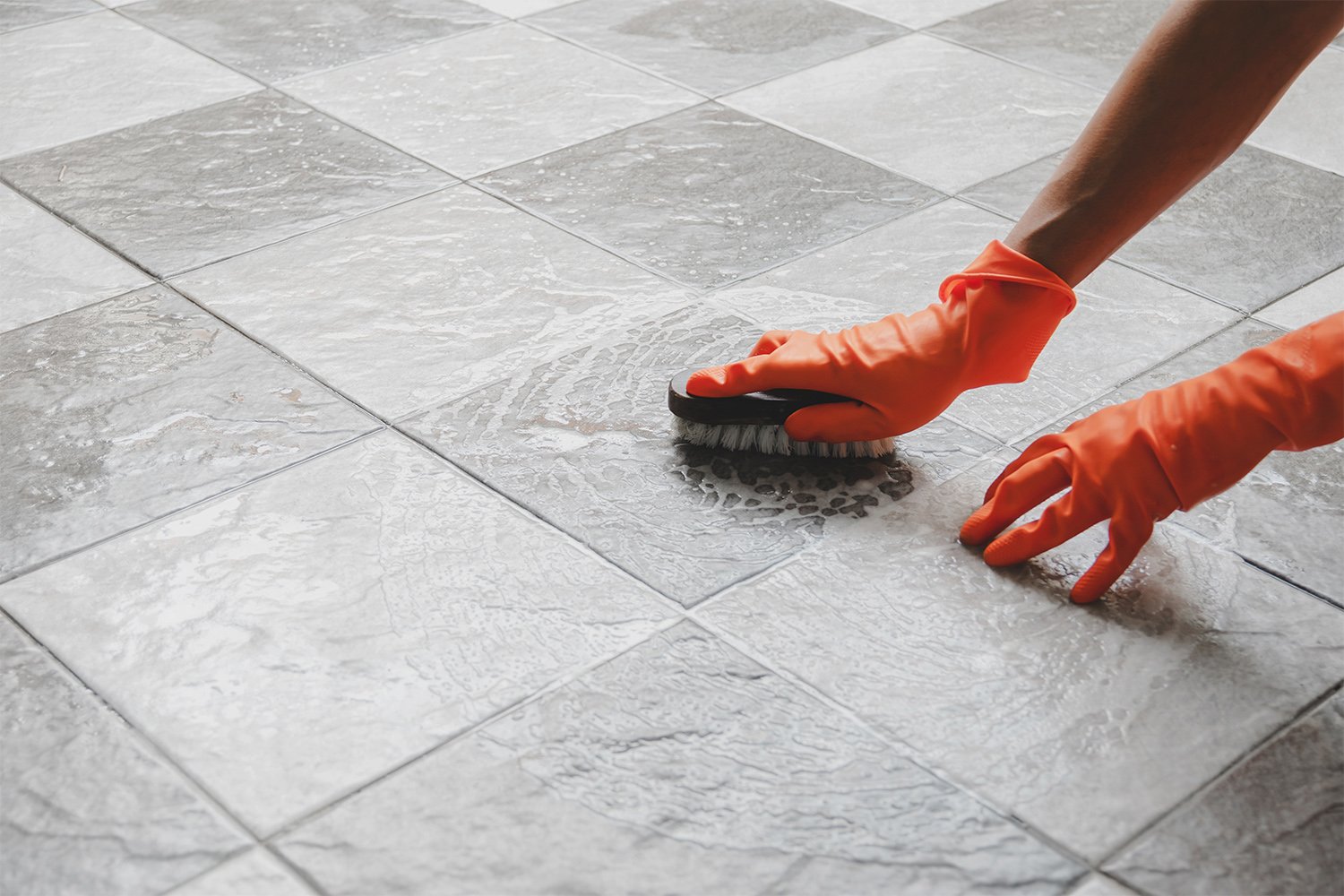Water Damage Cleanup Guide: How to Restore Your Home Quickly After a Flood
Keep long-term damage at bay


No matter how much you prepare for home emergencies, like a flash flood or roof leak, they can feel disorienting when they happen. But with some knowledge and quick action, you can prevent permanent damage and mold growth. Learn all about water damage cleanup and the steps for how to mitigate the impact of water in your home.
The Dos and Don’ts of Water Damage Cleanup

Floods are the most common natural disaster in the United States, according to the U.S. Department of Homeland Security. Whether you’re dealing with a minor or major emergency, you should keep a few things in mind to protect your family and belongings during the flood damage cleanup process.
Dos:
Act quickly, as mold and mildew can develop within 24 to 48 hours of water exposure.
Wear personal protective equipment (PPE), including safety goggles, rubber boots, a hard hat, a face mask, and gloves before entering the property.
Find the source of the flood and shut it off, if possible.
Look for damaged power and gas lines and the smell of leaking gas. If you notice any of these problems, vacate the space immediately.
Keep an eye out for cracks in the foundation, broken pilings, shifted stairs, and slanted floors and walls. If you notice these issues, leave the home or do not enter it.
Watch out for falling plaster and holes in the floor.
Turn off the water and power to your home while wearing PPE. Do not turn off your water or electrical systems if you need to stand on wet ground or in standing water.
Take photos of the damage to your home and any personal belongings for the insurance claim process.
Contact your home insurance company to begin the claims process.
Check for rodents, insects, and snakes that may have entered with the floodwater.
See if the water from your faucets is safe to drink and use for cleaning.
Flush your toilets before using them to ensure there are no clogs or issues.
Watch for cabinets, built-in shelves, and other heavy items that might fall.
Repair floor, roof, and walls with temporary or permanent solutions.
Remove debris, mud, and damaged items.
Use a shop vac or wet vac to remove standing water and water trapped in walls.
Use dehumidifiers and desiccants (materials that absorb moisture) to dry out the home.
Open your doors and windows to allow for ventilation and faster drying.
Call a local water cleanup company or electrician if you need help.
Don’ts:
Don’t enter the home if you notice major structural damage.
Don’t shut off the power on a wet floor or in standing water.
Don’t walk on sagging floors and floors above sagging ceilings.
Don’t turn on electrical appliances, ceiling fans, or lights until you’re sure it’s safe.
Don’t drain a flooded basement too quickly. A rapid change in pressure can cause the foundation to collapse.
Don’t attempt any electrical or structural repairs yourself unless you have experience.
Don’t connect a generator to your home’s power system.
Don’t use a household vacuum to remove water, debris, and mud.
Don’t let garbage pile up, as this increases the chances of contamination and pests.
1. Shut Off the Power
No matter the extent of the water damage or type of floodwater, it’s important to shut off the power to your home. Safety first: Begin the flood damage cleanup process by putting on rubber boots. You’ll want to shut off the gas before entering your house.
Next, shut off the power using a dry stick while standing in a dry spot. If your circuit breaker box is in a waterlogged area (or there is any water on the floor), don’t attempt to shut off the power yourself. Call an emergency electrician or the power company to shut it off for you.
As you begin cleaning, watch out for falling plaster, ceiling holes, or flooring holes.
2. Identify the Water Damage
If the home is safe and stable enough to enter, you can assess the water damage yourself. Look at your foundation, drywall, ceilings, insulation, flooring, and HVAC systems.
In your foundation and staircases, watch for cracks, shifting, buckling, and caving. In your walls and furniture, watch for water spots, soft areas, and sagging. If your heating and air conditioning units got wet, there could be internal electrical damage.
You may also want to hire a local water cleanup pro to inspect your home, especially if it’s a severe flood or you’re filing an insurance claim.
There are four classes of water damage, which impacts the cost and process for water damage restoration.
Class 1: Minimal Damage
You can often repair the issues independently or hire a pro at a low cost. Examples include a small leak in your faucet or an area of damp carpet.
Class 2: Entire Room Damage
When a room is full of water, including the walls up to a foot, it’s considered class 2 damage. You can tackle restoration or hand it off to a pro to remove moisture, handle cleanup, and tackle repairs.
Class 3: Saturation
If the walls, ceiling, floors, and even subfloor and insulation are saturated, it’s a class 3 issue that nearly always needs a pro for cleanup.
Class 4: Long-Standing Water Damage
Water damage from a storm or flood can saturate wood, brick, and stone. If these materials are wet to their core, it’s considered severe damage and is too risky to clean up alone.
3. Know the Type of Floodwater
The color and type of floodwater also play into whether you should clean it yourself or have a pro come in. Knowing the type also provides valuable information to your insurance company. While only licensed water damage professionals can categorize water damage, it’s helpful to understand the scope of the damage and the potential cost of cleanup.
Category 1: Clean Water
The water is clear and often occurs from leaky faucets, toilet tanks, rainwater, burst pipes, and water heaters.
Category 2: Gray Water
Cloudy or gray water can contain harmful contaminants from sources such as an overflowing dishwasher, toilet, or washing machine. You can clean up small areas with gray water, but extensive saturation is best handled by a pro to decontaminate everything.
Category 3: Black Water
Dark, muddy water is the most contaminated and can soil furniture, bedding, carpet, and more. It’s difficult to restore items affected by black water, and replacement is often necessary. Black water can pose health risks from flooding, storms, contaminated groundwater, and sewage backups. If you have black water, call in a pro.
4. Pump Out the Water (Carefully)
If you’re going the DIY route or still waiting for help from professionals, focus on removing the excess water from your home. Use a wet-dry vacuum, electric water transfer pump, or sump pump to remove standing water.
Depending on the severity of the flooding, you may have to do this step in stages. In cases of severe flooding, the Federal Emergency Management Agency (FEMA) recommends you take the following steps:
Mark a spot on the wall where the water stands.
Pump out 1 foot of water.
Wait 24 hours. If the water hasn't risen, pump out another foot.
If the water stays at the same level after 24 hours, you can up the amount you pump out to 2 to 3 feet per 24 hours.
If you remove water too quickly when the ground is saturated, your floor or walls could buckle, potentially causing structural damage. If you’re concerned about this, call a structural engineer.
5. Dry Off Your Home
Once most of the water is out, start the drying process. Open all doors and windows. Set up fans to maximize the airflow in your home.
If your vents were exposed to floodwater, wait to turn your HVAC unit back on until you have the ducts inspected and cleaned by an HVAC technician.
6. Tackle Your Floors
Dealing with flooded floors calls for elbow grease and, unfortunately, in many cases, sacrifice. Depending on the severity of the water damage and how fast you act, you may be able to salvage your flooring with a little hard work and patience.
Carpet
While cleaning your carpet after a flood is sometimes possible, anything that’s been underwater for more than 24 hours has to get the boot. Carpeting is like a sponge, and mold and mildew are no joke—when in doubt, throw it out.
Tile
As for your tile flooring, scrub out dirt and grime with soapy water. Next, clean the floor with 1 cup of chlorine bleach diluted in 1 gallon of water. Dry-mop the floor to absorb any remaining water.
Hardwood
Use a shop vacuum to remove all the standing water from the floor and clean the area with a wood-safe disinfectant. Then, dry the wood with a dehumidifier. What’s most important here is patience—it could take a day or two for the wood to dry.
If the floor is crowning or cupping, consider bringing in a hardwood repair expert to help.
7. Dispose of Anything You Can’t Salvage
Perhaps the most difficult part of the flood damage cleanup process is disposing of any belongings that aren’t salvageable.
This includes:
Mattresses
Pillows
Blankets and bedding
Upholstered furniture
Stuffed animals
Rugs
Books
Buckled furniture
Just like with carpeting, throw it out if you’re in doubt. According to FEMA, mold and mildew can cause health concerns over time, like respiratory issues, nasal congestion, headaches, and more.
8. Restore Important Paper Documents
Sometimes, there are ways to save waterlogged documents like birth certificates, marriage licenses, or social security cards. Blot the paper with a clean rag or sponge to remove as much extra moisture as possible. Hang the documents on a laundry line to dry (but don’t use a hair dryer or fan pointed directly at them).
Avoid pulling water-damaged papers apart; dry them in small stacks in a sandwich-like approach, placing them on an absorbent material (like a towel) with another towel on top. Add a heavy item, like a brick or wood block, on top of the stack to help press the water out.
9. Mitigate Mold and Mildew
If the mold spread is greater than 10 square feet, hire a local mold removal company to handle removal safely and thoroughly. For smaller mold and mildew issues, it’s possible to clean it on your own—though you should always contact the pros if you’re uncomfortable handling it.
Should You Hire a Flood Remediation Company?

Dealing with even an inch of floodwater can be a stressful and often exhausting experience for a homeowner. In some cases, it can be downright dangerous. But hiring an experienced flood remediation company will help take some of that weight off your shoulders.
Professional water damage cleanup crews know how to handle everything from flooded carpeting to cupboards. On average, water damage restoration costs $3,300. Your estimate will depend on the water damage's severity, type, and location. Your insurance company may help cover some, if not all, of the costs associated with flood damage cleanup.
And while this price may seem steep, it’s often worth it. Flood damage cleanup should begin within 24 hours of exposure to increase your chances of saving any belongings or your home’s foundation. A professional company often offers emergency services and can bring all its own equipment—meaning the team can get to work faster and more efficiently than you’d be able to yourself.
Common Causes of Water Damage
From faulty piping to unpredictable weather, water damage can happen before you even know there’s an issue. But if you aren’t sure what caused the water damage in your home, you’ll want to conduct a quick investigation.
If the flooding wasn’t due to natural causes, it’s likely you have an issue with one of the following:
Water supply line leak
Leaking appliances or plumbing
Clogged gutters
Cracked foundation
Overflowing sinks, toilets, or tubs
Blocked drains or backed-up sump pump
Excess AC condensation
These are just a few of the ways water damage can happen. If you notice any of these issues or anything else that might be a cause for concern, contact a local water damage restoration company.
Taylor Sansano contributed to this piece.








.jpg?impolicy=leadImage)






